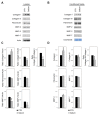Effects of a natural multi-component compound formulation on the growth, morphology and extracellular matrix production of human adult dermal fibroblasts
- PMID: 31572512
- PMCID: PMC6755435
- DOI: 10.3892/etm.2019.7872
Effects of a natural multi-component compound formulation on the growth, morphology and extracellular matrix production of human adult dermal fibroblasts
Abstract
The extracellular matrix (ECM) creates a tissue microenvironment able to regulate cellular signaling. The loss of ECM plasticity is associated with several pathologies, especially those involving chronic inflammation, therefore, the ECM represents a potential therapeutic target for certain conditions. The present study investigated the effects of a natural multi-component compound formulation, Galium-Heel®, on the growth, morphology and ECM production of human dermal fibroblasts (HDF). The effects of the formulation on HDF growth and morphology were assessed by sulforhodamine B assay, trypan blue exclusion staining, FACS and ultrastructural analyses. The effect of the compound on reactive oxygen species production by HDF was performed by dichlorofluorescin diacetate assay. The expression of ECM components, matrix metalloproteinases (MMPs) and signaling molecules was analyzed by western blot analysis. The present results demonstrated that Galium-Heel® did not significantly affect HDF growth, survival, cell cycle or morphology indicating the biocompatibility of the formulation. The formulation demonstrated antioxidant activity. Galium-Heel® was able to modulate ECM by regulating collagens (type I and III) and MMPs-3 and -7 expression. In addition, the formulation was able to regulate molecules involved in TGF-β signalling, including mitogen activated kinase-like protein, GLI family zinc finger 2 and pro-survival proteins such as AKT. The present results demonstrating the effects of a natural multi-component compound on ECM composition, highlighted the possibility of pharmacologically modulating ECM molecules. The recovery and the maintenance of ECM homeostasis might be considered as a potential therapeutic goal to ameliorate pathological conditions.
Keywords: Galium-Heel®; collagen; extracellular matrix; fibroblasts; natural compound.
Copyright: © Benvenuto et al.
Figures




Similar articles
-
Beneficial regulation of matrixmetalloproteinases and their inhibitors, fibrillar collagens and transforming growth factor-beta by Polypodium leucotomos, directly or in dermal fibroblasts, ultraviolet radiated fibroblasts, and melanoma cells.Arch Dermatol Res. 2009 Aug;301(7):487-95. doi: 10.1007/s00403-009-0950-x. Epub 2009 Apr 17. Arch Dermatol Res. 2009. PMID: 19373483
-
A Novel Compound Rasatiol Isolated from Raphanus sativus Has a Potential to Enhance Extracellular Matrix Synthesis in Dermal Fibroblasts.Ann Dermatol. 2013 Aug;25(3):315-20. doi: 10.5021/ad.2013.25.3.315. Epub 2013 Aug 13. Ann Dermatol. 2013. PMID: 24003274 Free PMC article.
-
Modulation of collagen type I, fibronectin and dermal fibroblast function and activity, in systemic sclerosis by the antioxidant epigallocatechin-3-gallate.Rheumatology (Oxford). 2010 Nov;49(11):2024-36. doi: 10.1093/rheumatology/keq208. Epub 2010 Jul 13. Rheumatology (Oxford). 2010. PMID: 20627968
-
Skin aging from the perspective of dermal fibroblasts: the interplay between the adaptation to the extracellular matrix microenvironment and cell autonomous processes.J Cell Commun Signal. 2023 Sep;17(3):523-529. doi: 10.1007/s12079-023-00743-0. Epub 2023 Apr 17. J Cell Commun Signal. 2023. PMID: 37067763 Free PMC article. Review.
-
Cooperation of liver cells in health and disease.Adv Anat Embryol Cell Biol. 2001;161:III-XIII, 1-151. doi: 10.1007/978-3-642-56553-3. Adv Anat Embryol Cell Biol. 2001. PMID: 11729749 Review.
References
LinkOut - more resources
Full Text Sources
